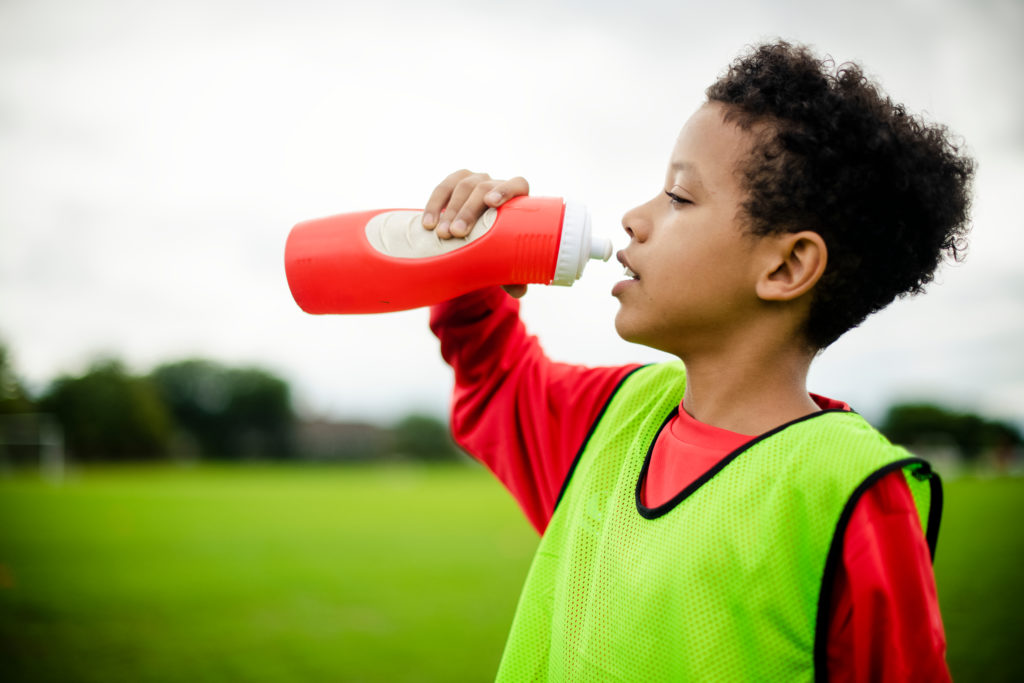Help Your Athletes Beat the Heat and Dehydration
Proper hydration is important for day-to-day life but also plays a critical role in the physical performance of athletes of all ages. During their sports season, kids are often playing in hot and humid environments, from indoor gyms to outdoor fields in the summer. No matter what season it is or the environment, the muscles generate heat during exercise which in turn means, you guessed it, sweaty kids. Sweating is the primary way the body regulates core temperature during exercise, but it also means a loss of fluids. If your young athletes aren’t replenishing the fluids they are losing, it puts them at risk of dehydration and related complications [1, 2].
What are the signs of dehydration?
Dehydration during exercise occurs when you lose more fluid via sweat than you drink. Sweating during activities, like school, recess, and sports brings heat from the muscles to the skin. The evaporation of the sweat off the skin is how the body releases heat. If you don’t replace the fluid you sweat out, you will gradually become dehydrated. . When an athlete loses more than 2% of their body weight in fluid, performance begins to be impaired and the athlete’s risk for heat-related complications increases[3]. A severely dehydrated athlete may experience fatigue, dizziness, dry mouth, increased thirst and disorientation, and ultimately heat illness.
What types of fluids should athletes drink?
Day-to-day when resting, water is a great option to hydrate. But on especially hot summer days, during long-duration activities or when playing back-to-back games in a tournament, athletes need fluids with electrolytes to replenish what is lost in sweat[2, 3]. Including carbohydrates in a sports drink not only helps replenish an important fuel source that the athlete has used but also supports the absorption of fluid, supporting overall hydration[4].
Gatorade’s proven formula has a blend of electrolytes to help replace what your athletes lose in sweat plus it packs a great source of quick energy for your athlete after a long game or practice.
For athletes exercising 60-minutes or more, research has shown that drinking a sports drink like Gatorade provides benefits over water. Factors to consider during exercise are duration, intensity, and environmental elements such as heat or humidity. For athletes who are doing shorter or lower intensity exercise, hydration is still essential but they may not need or want carbohydrate energy.
Gatorade’s Hydration Resources
Because hydration is such an important part of an athlete’s performance, Gatorade has created some resources to support athlete hydration and keep athletes safe in the heat.
- Gatorade – Athlete Hydration Chart – This visual is great to hang in your locker rooms or near the restroom at your facility to give you athletes an easy-to-follow guide to help them determine if they are hydrated.
- Recognize Dehydration – A simple reminder card with the symptoms of dehydration listed can go a long way in helping your athletes, and their families, recognize signs of dehydration
- Athlete Weight & Hydration Chart – Every athlete is different and should hydrate to meet their body’s needs. This resource is designed to track body weight change pre and post-exercise to determine how much fluid they need to rehydrate after. For every pound they have lost, they need to drink 20-24 oz of fluid.
-
Bergeron, M.F., Hydration in the Pediatric Athlete – How to Guide Your Patients. Curr Sports Med Rep, 2015. 14(4): p. 288-93.
-
American College of Sports, M., et al., American College of Sports Medicine position stand. Exercise and fluid replacement. Med Sci Sports Exerc, 2007. 39(2): p. 377-90.
-
Thomas, D.T., K.A. Erdman, and L.M. Burke, American College of Sports Medicine Joint Position Statement. Nutrition and Athletic Performance. Med Sci Sports Exerc, 2016. 48(3): p. 543-68.
-
Shi, X., et al., Effects of carbohydrate type and concentration and solution osmolality on water absorption. Med Sci Sports Exerc, 1995. 27(12): p. 1607-15.



